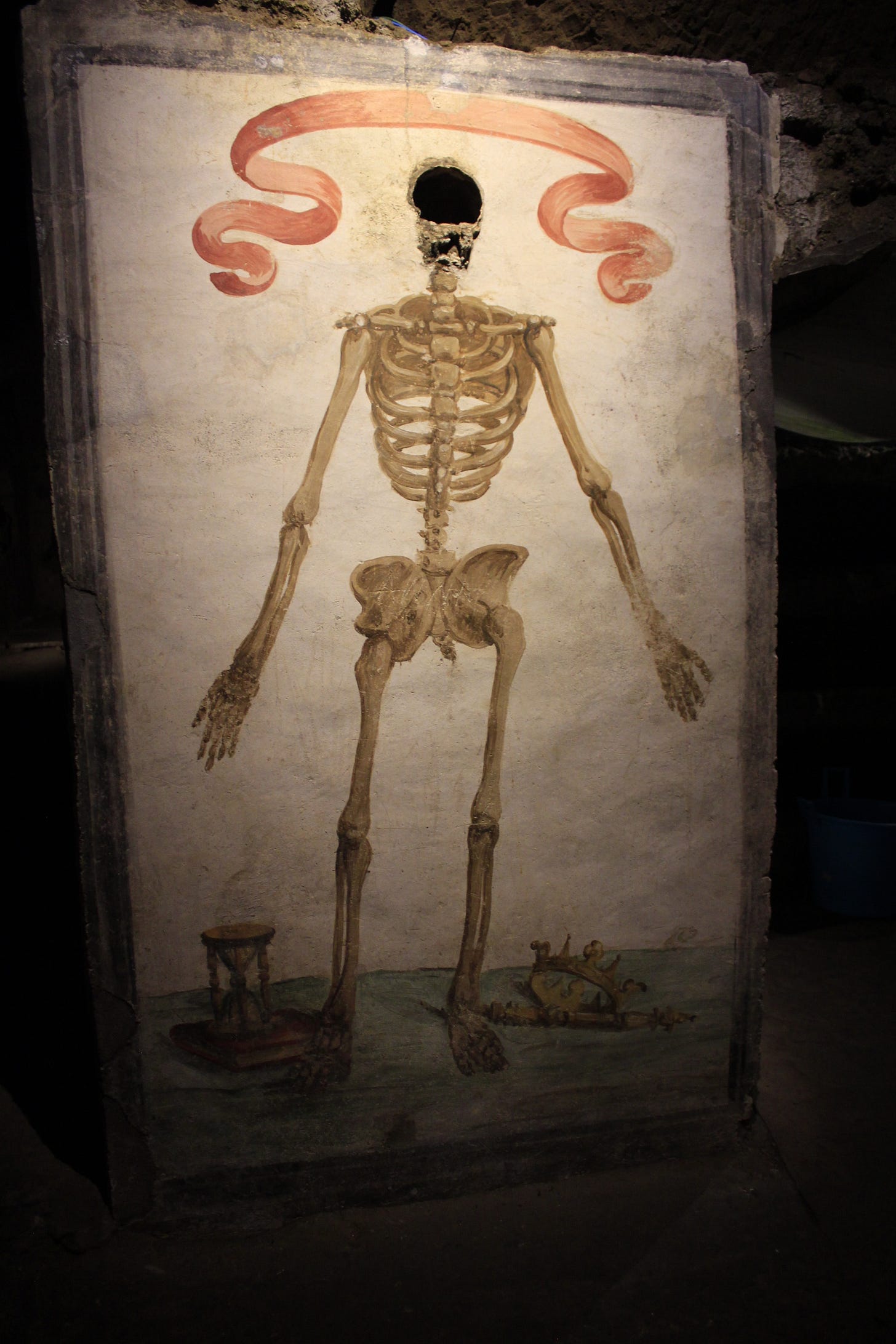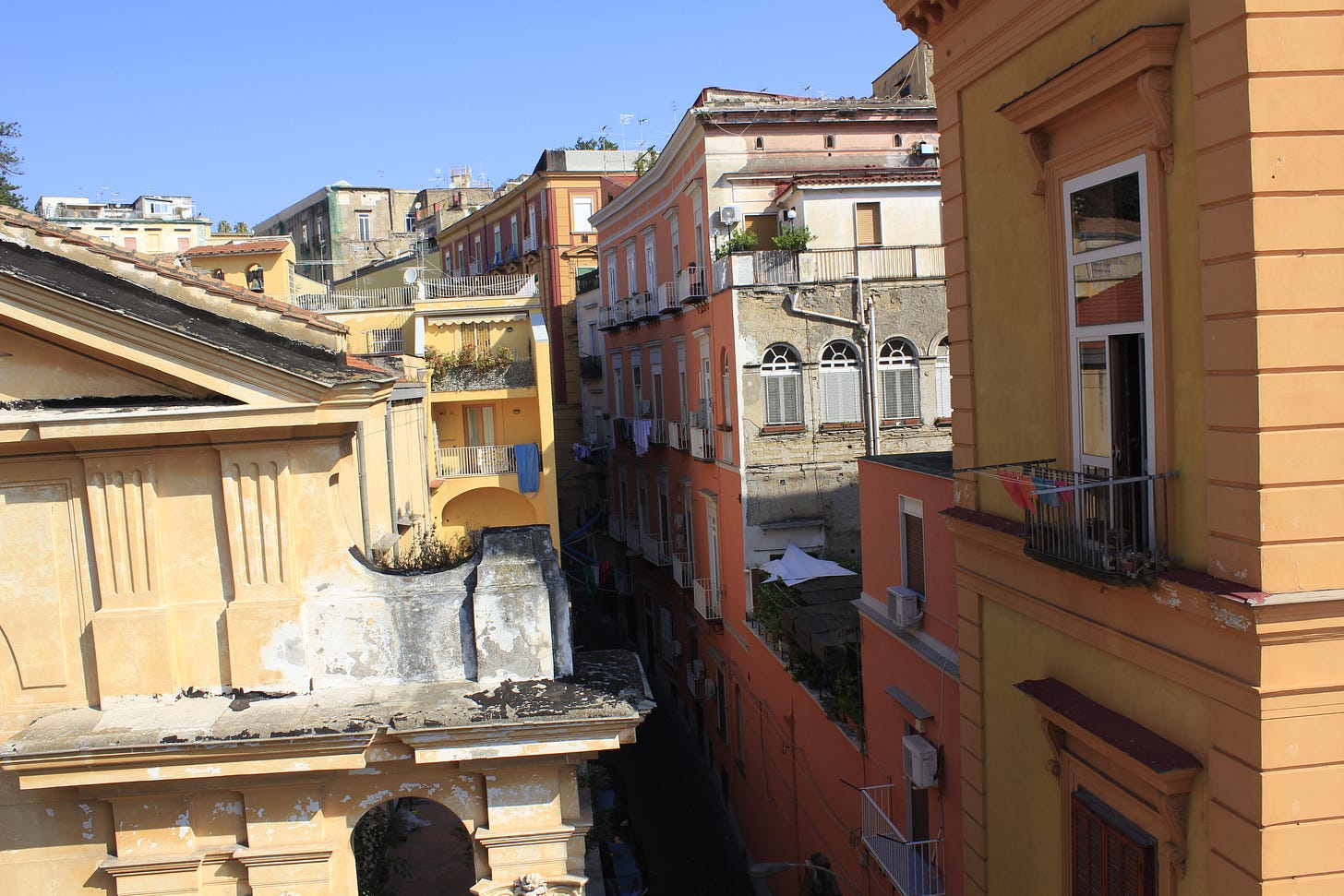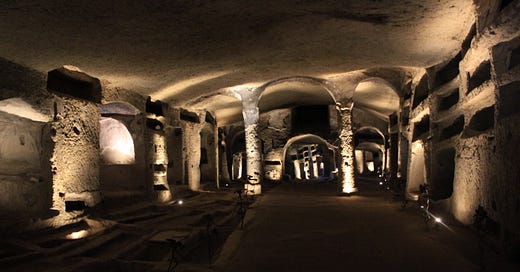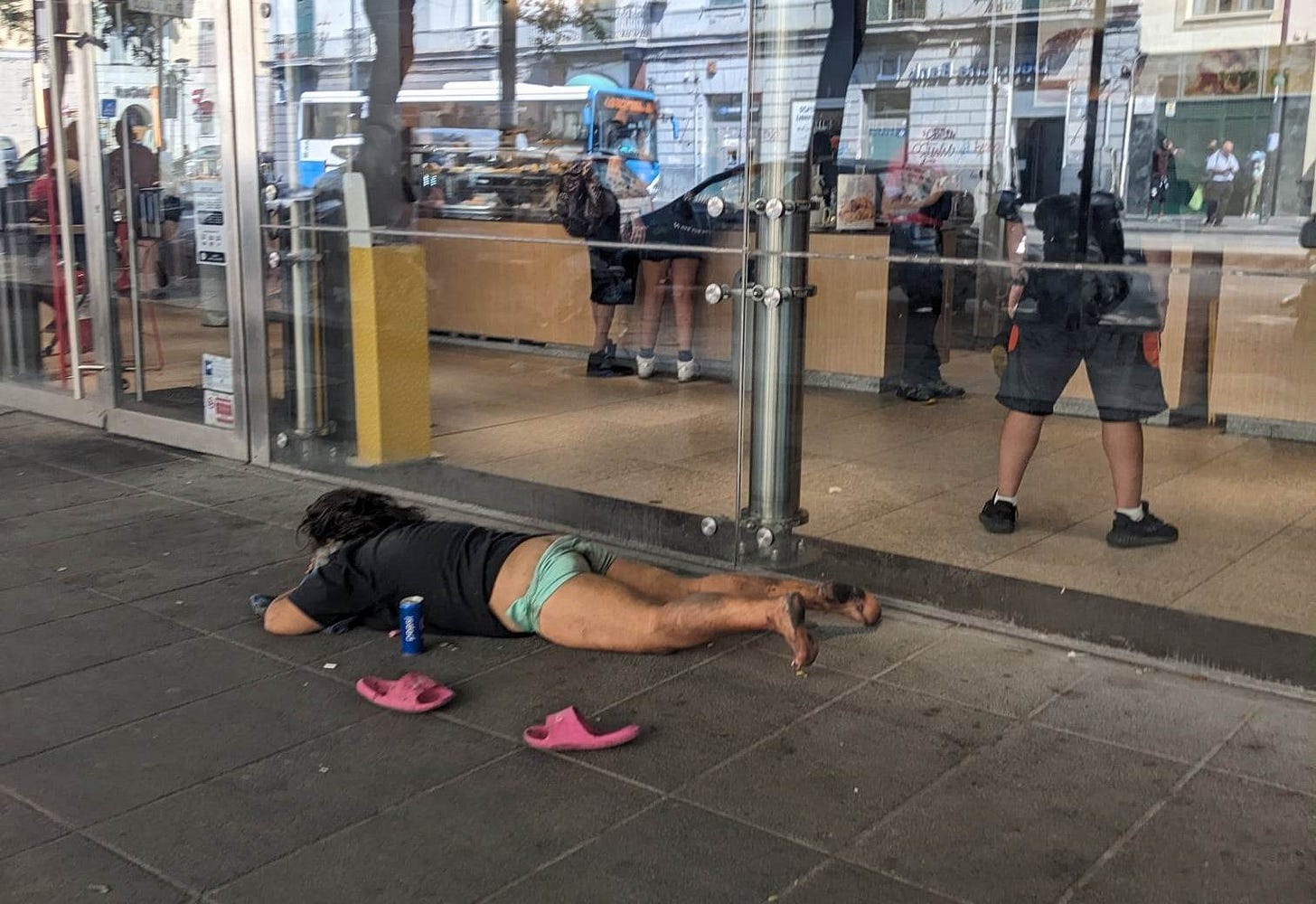I assume it goes without saying that the whole time I was in Italy, “That’s Amore” was stuck in my head. At the beginning, they go, “In Naaaapoliiiiiiiii….”
Last week, I too, was in Naaaapoliiiiii. And it was lovely. I’ve heard mixed reviews of Napoli (Naples, in English). Some people say it’s too crowded and busy and dirty and the whole time you feel like you’re going to get hit by someone’s Vespa. To that I say: Is death by Vespa on the Mediterranean Coast really such a bad way to go?
I didn’t feel overwhelmed by the traffic; just hot, the same way I felt everywhere else in Italy.1 I had booked tickets to go visit the Catacombs of San Gennaro while I waited for my room at a bed and breakfast to be available. Of course, I did not look up how far the catacombs were from the train station before I booked my tickets, and of course I left for the train station in Rome in a mad rush without breakfast because of poor planning, so I really had to stop and get a cornetto and a coffee on my walk to the catacombs to avoid dying of starvation, and found myself absolutely booking it up a giant hill Under The Neapolitan Sun.2 So I was particularly grateful for the cool, grotto-y conditions of the catacombs.
The Neapolitan giving the tour told us about San Gennaro, the patron saint of Naples, and about how his bones used to be here. (He kept saying “the body bones,” by which he meant the bones, not including the skull, but still sounded very fun and vaguely like scatting: ba dee doo bo-dee bones.)
Well, first they were buried somewhere else. Then they were brought to the catacombs, and it became a pilgrimage site. Then they moved to a sanctuary in a different city and everyone forgot about them for 200 years (which is normal, I feel like? I don’t expect anyone to care about my bones in 200 years, but then, I’m not a martyr). And then they came back to Naples to live (to exist?) in the Naples Cathedral.
Imagine people caring that much about your bones after you die. I wonder if people cared so much about him while he was alive. I wonder if it makes a difference to him now, where his bones are.
For what a big deal he is, we don’t actually know that much about San Gennaro, who is also the patron saint of volcanic eruptions and blood banks.3 There are some fun legends, though, about how the pagans tried to throw him to the beasts, but the beasts refused to eat him, or that they threw him in a furnace and he just strolled out, unscathed. Anyway, when both or neither of those worked, they cut off his head, which was much more effective. He’s irrefutably dead now.
Anyway, at the end of our catacomb tour, the man gave a nice speech about how the San Gennaro neighborhood used to have a super bad reputation. “Twenty years ago, there was only one piece of information you could find about our neighborhood, Rione Sanità” he said.
“And it was, ‘Don’t go there,’” said a woman in our tour group.
“Exactly,” he said.
But then in 2006, our tour guide and some of his friends, just five young dudes, set out to change the image of the neighborhood by revitalizing its artistic and cultural heritage. They started the Cooperative La Paranza, which was responsible for opening the Catacombs of San Gennaro to the public. They’ve also done the same with other sites, and it’s spawned a little ecosystem of cooperatives to foster local businesses, support youth and make their neighborhood a better place to live. They saw that something they loved was in a bad place, and they set out to make it better, which, not to be too dramatic here, but sounds like the purpose of life. They have this beautiful St. Augustine quote on their website.
“Hope has two beautiful daughters: Anger and the Courage to see that things do not remain the way they are.”
My ticket also included entrance to the Catacombs of San Gaudioso, which I hadn’t realized. I managed to stumble into the start of the next tour just in time. We went into a church, then under a church. Our tour guide explained that someone was digging a wine cellar back in the 90s, only “to accidentally find the fresco of St. Mary of Health. Casually.”
This tour was even more interesting, I thought, because we got to talk more extensively about how they prepared dead bodies for the catacombs by draining all the fluids out. What a job it must have been to be a “schiattamuorto,” or the guy who had to poke a bunch of holes in corpses so their fluids would drain out. I am curious if any of those skills are transferable, like if you could use the hole-poking skills you learn as a schiattamuorto to launch a career in another field. It doesn’t matter though, because the schiattamuorti pretty much always fell ill from constant exposure to corpse fluids, and often died young.
My favorite part was seeing the frescoes in a place called the Hall of Skulls. If you were rich or high up in the church, when you died, you could have your skull mounted on the wall and then the rest of your body painted as a fresco.

This meant seeing fun skeleton paintings, with objects or outfits that represented their social class during life. A writer skeleton holding a book, a soldier skeleton holding a sword. The guy who painted all the frescoes, Giovanni Balducci, did all the work for free, in exchange for having a burial spot in the hall too. So, there’s also a skeleton holding a paintbrush, and looking a slightly different from all the other skeletons because Balducci wasn’t alive to paint his own death fresco.
One of the strangest things about both catacombs, if you really think about it, is that they didn’t have any bodies in them. At some point in Naples’ history, the bodies all got moved to cemeteries, sort of because of hygiene, sort of because of politics, as I understand it. Is the symbol of something sometimes more impactful than the thing itself?
Because seeing frescoes like this one made me feel all romantic and somber about the idea of life after death. The depictions are sweet and simple, almost like a child’s drawing. But maybe I would have been even more affected by the sight of two real dead bodies holding hands.
As I was walking through the streets of Naples, I kept thinking, “This city is so alive.” These people are so alive.” I ate so much and walked so much, felt so aware of what it means to be a human – to consume energy, to burn energy, to look at things and feel them and to gather up memories to share with other people.

But at the same time, there were reminders of death – memento mori – everywhere. Maybe that’s the key to really feeling alive, is allowing yourself to be more keenly aware of its opposite.
My friend Rosario told me in Italy they say “Vedi Napoli e poi muori”: See Naples, then die. As in, once you’ve seen this beautiful city, you can die happy. But maybe also as in, see Naples, then carry a new awareness of death with you.
I’m not dead yet, but thank God when I am, I’ll hold within me the memory of Naples (and how perfect its pizza is, but no blog post could begin to capture that).
Question of the Week: Have you ever seen something, or experienced something, that made you feel like “Now I can die happy”? (Personally, I think I am too greedy for new experiences and meeting new people.)
Recommendation of the Week: The poem “For the young who want to” by Marge Piercy.
My sweet aunt in France texted me and asked if it was as hot in Italy as it was for them. “YES” I texted back, trying to see my phone to type through the sweat in my eyes.
I am unclear on the details here, but allegedly someone saved a vial of San Gennaro’s blood after he died. Because it’s old as hell, it’s solidified, but a few times a year, it just… liquefies? And then everyone celebrates. This might be a miracle, or it might not be blood at all, but rather a substance that just turns to liquid when disturbed and stays solid otherwise.








So much fun to read your musings! I passed through Naples on a tour bus on the way to Pompeii and back, but wished I could’ve spent more time there. Next time for sure.
This was so good, loved it! I really enjoy the phrase, See Naples, Then Die. And I hadn't considered it, but you're right, being killed by an Italian on a vespa wouldn't be such a bad way to go.